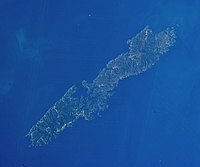
Photo from wikipedia
ABSTRACT The Forest and Forestry Basic Plan set Japan’s domestic timber supply goal of 32 million m3 by 2020. To achieve the goal, a large increase in thinned timber production… Click to show full abstract
ABSTRACT The Forest and Forestry Basic Plan set Japan’s domestic timber supply goal of 32 million m3 by 2020. To achieve the goal, a large increase in thinned timber production will be required. The purpose of this study was to calculate and understand the current situation of commercial thinning volumes in all 47 prefectures as a basis for projecting future changes in thinned timber production. First, thinning records at prefectural level were obtained. Thinning areas by age classes and commercial thinning ratios were predicted for those prefectures without available thinning records using clustering, discriminant analysis, and logistic regression. A thinning yield table was also constructed for each prefecture, based on the mean volume of six tree species assuming certain thinning types, intensity, and timings. Finally, the commercial thinning volume was calculated for each prefecture by multiplying thinning area, thinning volume per unit area in a yield table, and commercial thinning ratio. Graphs of commercial thinning volumes suggested that Hokkaido and Kumamoto had particularly high thinning volumes, Akita, Nagano, Shizuoka, Oita, Miyazaki, and Kagoshima also had relatively high volumes. The calculation results in prefectures were considered reasonable, based on calibration and validation that reflected the regional difference in thinning trends.
Journal Title: Journal of Forest Research
Year Published: 2018
Link to full text (if available)
Share on Social Media: Sign Up to like & get
recommendations!